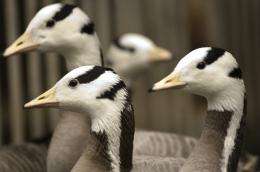Invigorated muscle structure allows geese to brave the Himalayas: research

A higher density of blood vessels and other unique physiological features in the flight muscles of bar-headed geese allow them to do what even the most elite of human athletes struggle to accomplish - assert energy at high altitudes, according to a new UBC study.
Named for the dark stripes on the backs of their heads, bar-headed geese are native to South and Central Asia. Often bred in captivity as domestic garden birds, they migrate annually in the wild between India and the high altitude plateaus in China and Mongolia, flying over the world's highest mountains on their way.
"They fly at altitudes up to 9,000 metres," says UBC Zoology PhD student Graham Scott. "That's the equivalent of humans running a marathon at the altitudes commercial airlines fly."
Scott and colleagues from UBC and the University of Birmingham in the UK compared the physiology of bar-headed geese to low-altitude waterfowl such as barnacle, pink-footed and greylag geese. Their findings are published today in the journal Proceedings of the Royal Society B: Biological Sciences.
"We found approximately six to 10 per cent more aerobic muscle fibres in bar-headed geese compared to low altitude birds," says Scott. "There were also more capillaries - the body's smallest blood vessels - surrounding these fibres in bar-headed geese."
The team also found that the bar-headed geese's mitochondria - the cell's power sources - are distributed closer to the cell membrane and therefore closer to capillaries.
"These traits allow oxygen to be carried and diffused more effectively to the flight muscles," says Scott. Since these physical traits are inherent even in bar-headed geese that are bred in captivity and have never flown, the researchers believe they've evolved over time specifically to survive and perform at high altitudes.
Scott had previously found that bar-headed geese also breathe more when oxygen is scarce than most other animals do, suggesting they are fine-tuned for flying high. These insights allow scientists to better understand the limitations of human physiology and potentially find ways to exceed them.
Source: University of British Columbia (news : web)













